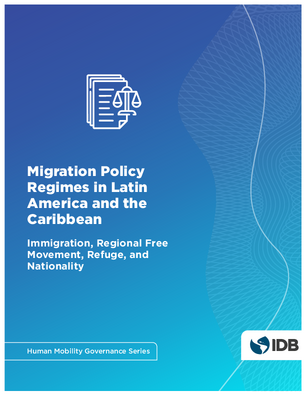Migration Policy Regimes in Latin America and the Caribbean Immigration, Regional Free Movement, Refuge, and Nationality
Date
Jul 2022
This report presents and describes a new database that was generated using 40 indicators that typi-fy the migration regimes of 26 countries in Latin America and the Caribbean (LAC) that are borrow-ing members of the Inter-American Development Bank (IDB). These indicators have enabled us to compare these migration regimes along multiple dimensions, identify subregional patterns, and ob-serve trends in the recent evolution of these pol-icies.
The indicators are grouped into six areas: inter-national instruments, which covers each coun-trys involvement in treaties and other multilateral agreements; regional instruments, which analyzes whether countries are party to agreements cover-ing the Americas or its subregions; visa-free entry rights, which measures whether a visa is required to enter the country; access to temporary resi-dence, which examines preferences in the granting of residence permits and regularization processes for irregular migrants; rights while resident, which looks at migrants access to healthcare, education services and the labor market, family reunification, voting rights, and permanent residence; and na-tionality, which measures whether the nationality of a given country is only obtained at birth or can be acquired through a subsequent naturalization process.
The value assigned to each indicator is backed by a reference to the legal instruments that define the policy in question. For most indicators, a text containing additional information explaining the specific case is also provided. This is a unique da-tabase for LAC and is included in Annex II of this report. It can also be accessed through the IDB Mi-gration Unit web page.
The indicators are grouped into six areas: inter-national instruments, which covers each coun-trys involvement in treaties and other multilateral agreements; regional instruments, which analyzes whether countries are party to agreements cover-ing the Americas or its subregions; visa-free entry rights, which measures whether a visa is required to enter the country; access to temporary resi-dence, which examines preferences in the granting of residence permits and regularization processes for irregular migrants; rights while resident, which looks at migrants access to healthcare, education services and the labor market, family reunification, voting rights, and permanent residence; and na-tionality, which measures whether the nationality of a given country is only obtained at birth or can be acquired through a subsequent naturalization process.
The value assigned to each indicator is backed by a reference to the legal instruments that define the policy in question. For most indicators, a text containing additional information explaining the specific case is also provided. This is a unique da-tabase for LAC and is included in Annex II of this report. It can also be accessed through the IDB Mi-gration Unit web page.




